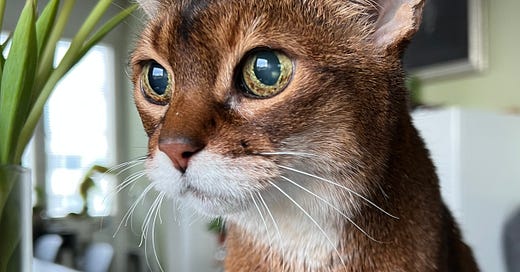To be honest, I don't consider myself an interesting person, and I've often struggled with what to include in my newsletters. My routine isn't exactly thrilling: I go to work, do my shopping, visit my mother at the care home, return home, whip up a quick meal, and then begin writing. That's essentially the gist of it.
Then a reader told that sure, there’s always interest in hearing how I manage to carve time for my writing, as well as the research needed for the books and how I conceive the plots in the first place. (Hi, Jeanne!)
I was staring at my newsletter screen on Substack, contemplating if there was something Egyptological that could pique interest in a newsletter. At that moment, our 20-year-old Abyssinian cat appeared, proclaiming that we had obviously never fed her, as her first and second breakfasts didn't count and her first lunch was still fifteen minutes away. (Yes, she must be related to hobbits.) I asked her, "You clearly remember how cats were worshiped in ancient Egypt, don't you?" (Of course, I wasn’t expecting a reply, I'm not quite that far gone, LOL). Then it struck me—I could write about a very famous ancient Egyptian cat. This particular feline features in Nephilim Quest #2 / Moon Daughter.
(And here is a pic of our Pipsa the day she turned 20 in February this year.)
An Ancient Prince’s Beloved Cat
While researching the 18th Dynasty of ancient Egypt (14th century BCE) for the Nephilim Quest, I found myself buried under stacks of books (because, who really uses the dining room table for meals?). As I flipped through a book on the animals of ancient Egypt, I stumbled upon the tale of a prince from the same royal family I was writing about, and his affection for his cat.
The prince was Thutmose, the older sibling of prince Amenhotep, and he was chosen to succeed his father, Amenhotep III, as the next pharaoh.
He had a beloved cat named Ta-Miu (meaning “she-cat”). Prince Thutmose’s love for Ta-Miu was so profound that he had a small limestone sarcophagus crafted for her – not just a simple cat mummy wrapping, but a real sarcophagus fit for royalty.
This tiny sarcophagus, now in the Egyptian Museum in Cairo, inspired chapter 42, The Death of a Prince of Nephilim Quest #2, Moon Daughter.
The Evolution of Bastet: From Fierce Lioness to Beloved Cat Goddess
Have you ever noticed how cats can quickly shift from being fierce hunters to affectionate friends? Interestingly, Bastet experienced a similar change! While studying Egyptology at the university, I was intrigued to learn that she wasn't always the sweet cat goddess we think she was.
In approximately 2000 BCE, you would have discovered that Bastet was portrayed as a formidable lioness goddess, battling alongside Ra to defend Egypt from chaos.
She was essentially a divine version of a supernatural warrior! The ancient Egyptians regarded her as their fierce guardian, which makes perfect sense if you've ever witnessed a cat defending her kittens.
(One of our cats, who has since crossed the Rainbow Bridge, was originally a barn kitten. When the neighbor's hunting dogs broke loose and entered the barn, approaching the kittens, the mother cat fearlessly confronted them. She leaped onto a dog's face, clinging to its snout with her claws long enough for the dogs to realize that heading back home was the wiser choice.)
Now, here's the intriguing part. In the New Kingdom era, where the Nephilim Quest series is set, Bastet began to reveal a gentler aspect. She evolved from a fierce lioness into a more graceful figure, resembling the elegant cat basking on your windowsill. Her role shifted from a warrior to a guardian of homes and families—though any cat owner will attest that our feline companions still take protecting their own territory role quite seriously!
The city of Bubastis (which the Egyptians called Per-Bastet) was like the ancient equivalent of a cat lovers’ convention center. By the time the Greeks and Romans came along, Bastet was so popular that her festivals drew huge crowds – imagine thousands of people celebrating cats! The Greeks even linked her to their goddess Artemis, which shows just how significant she’d become.
The Sacred Cats of Egypt
For the ancient Egyptians, cats held a significance that surpassed simply keeping them as pets. They were regarded as sacred embodiments of the goddess Bastet, serving both functional and spiritual purposes in society. Cats played a vital role in safeguarding grain supplies from rodents, an essential duty in an agrarian culture, and were also believed to ward off malevolent spirits.
In Bastet's holy city of Bubastis, archaeologists have unearthed extensive cat cemeteries containing thousands of mummified cats. Every mummy symbolizes an individual's prayer, hope, or act of devotion. But they also reveal a cruel side of Egyptian culture - eventually cats were bred to be killed as votive offerings.
How Ta-Miu ended up in Nephilim Quest
In chapter 46 of Nephilim Quest #2 / Moon Daughter, I took direct inspiration from Ta-Miu's story, particularly focusing on the puzzling lack of written records during Amenhotep III's reign. Typically, pharaohs were eager to proclaim their favored status with the gods, who bestowed life, prosperity, and health upon them and their people. The Egyptians avoided recording anything negative for future generations. So, if the wealthiest pharaoh of ancient Egypt suddenly ceased to glorify himself, it suggests that something quite distressing occurred.
One theory is that Amenhotep III's long and peaceful reign led to the development of extensive trade connections. Consequently, foreign vessels navigated the Nile up to Memphis. With ships came rats, and these rodents disembarked, bringing with them a devastating scourge that has led to massive fatalities globally—the bubonic plague, transmitted by fleas.
When the Nile overflowed, it transformed the Nile Valley into an expansive lake. Animals unable to swim to safety or retreat to the desert sought refuge in the villages. These settlements were located on elevated ground, created over time as new dwellings were constructed atop the ruins of old, crumbled ones—since houses were built from mud tiles, a sufficiently high flood would reduce them to mush. The theory suggests that rats fled the annual flooding by moving into these villages, where their fleas then transmitted the bubonic plague to both animals and humans.
Thutmose, the elder brother of Akhenaten, served as the high priest of Ptah in Memphis. As previously noted, Memphis was the landing site for trading ships. Therefore, it wasn't unreasonable to suspect that Ta-Miu hunted the diseased rats and transmitted the illness to the young prince.
It's uncertain whether a plague actually caused Prince Thutmose's death, as I mentioned in the story, but his demise allowed his younger brother Akhenaten to become king. If Thutmose had lived, we wouldn't have the magnificent bust of Nefertiti to admire nor the treasures discovered in Tutankhamun's tomb.
As a member of the royal family, Prince Thutmose had ample time and resources to plan for his cherished pet's passing, even commissioning that small stone sarcophagus for her.
Your Turn
Did you find other Egyptian elements in my books that you’d like to hear more about?
Reply to this email and let me know!
A reader lives a thousand lives!
Leena :)
(And I am working on Nephilim Quest #2 audiobook as well. Almost there. Here’s a link to the first audiobook of the series - click on the pic.)





